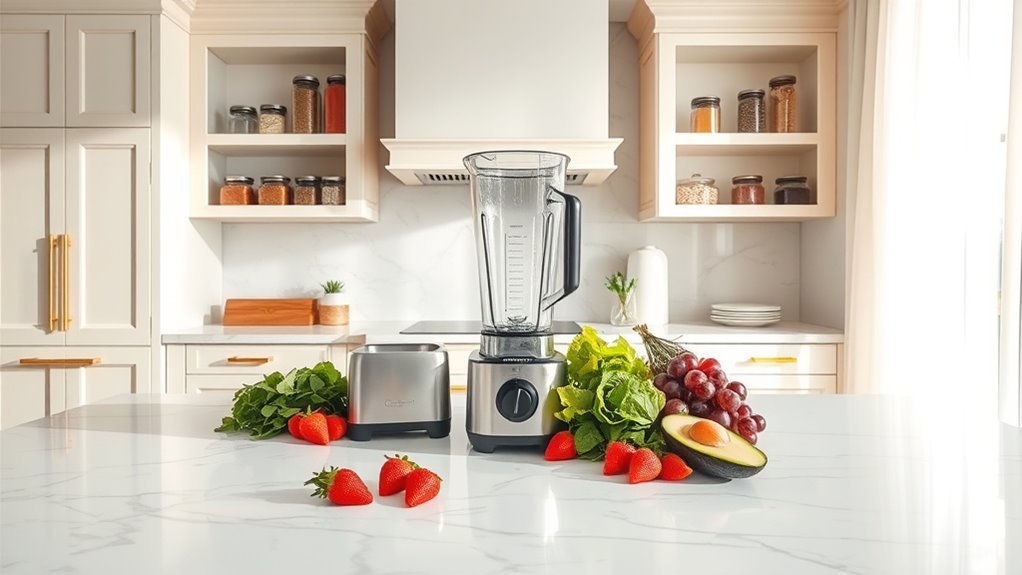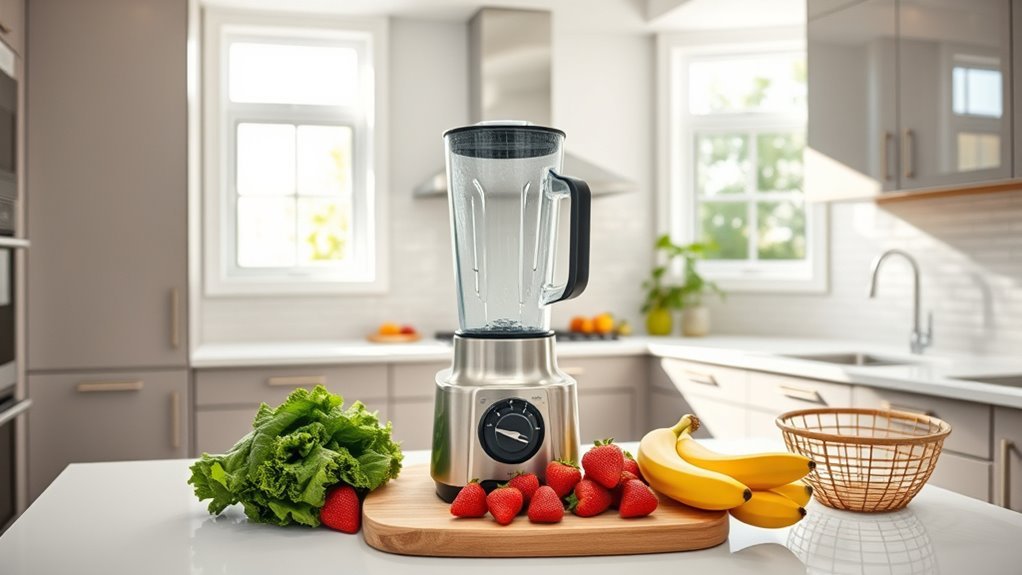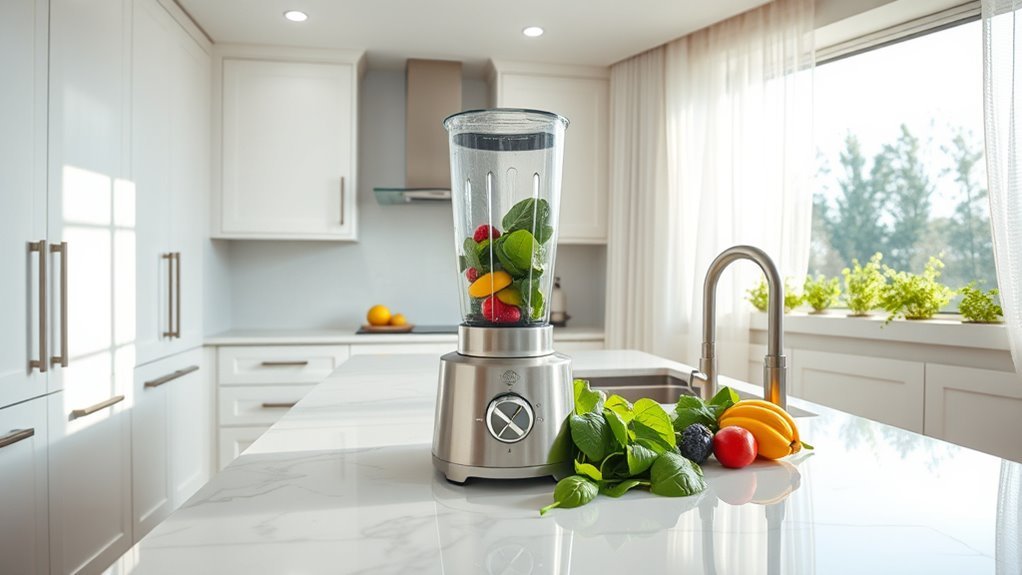We’ve found five proven ways to tame that roaring blender: strategic placement (keep it 2 inches from walls), sound-absorbing materials (thick rubber mats work wonders), proper maintenance (clean blades, tighten parts), and DIY solutions like building a soundproof enclosure. For immediate results, place your blender on a folded towel and position it away from corners. These battle-tested methods can slash noise by up to 30%, but there’s more to mastering the art of quiet blending.
Understanding Why Blenders Make Noise

When you understand why blenders create such a racket, you’ll be better equipped to tackle the noise problem head-on.
Let’s break down the symphony of sounds your blender produces.
First, we’re dealing with motors that spin at mind-boggling speeds – up to 35,000 rpm. That’s enough to create serious noise before we even get to the blades.
Speaking of blades, they’re slicing through ingredients at high velocity, generating friction and impact sounds that’ll wake the neighbors.
Add in vibrations from both components, and you’ve got a perfect storm of sound, especially on hard countertops that act like amplifiers.
Even the blender’s build quality matters – cheap motors and dull blades create extra rattling that no sound enclosure can fully fix. High-performance blenders often feature more powerful motors that can handle tough ingredients with less noise, making them a quieter option for blending tasks.
Strategic Placement for Minimal Sound
Three key factors determine your blender’s ideal placement: distance from walls, surface material, and surrounding space.
Let’s explore strategic placement that’ll dramatically reduce your blender’s noise footprint.
- Position your blender at least 2 inches from walls to prevent sound reflection – centered counter placement is best for minimizing reverberation.
- Avoid hard surfaces like concrete that amplify noise – opt for sound-absorbing materials such as rubber mats or silicone pads underneath.
- Choose a spot with minimal enclosed space around the unit to reduce sound bounce, and keep it away from quiet areas like bedrooms.
Additionally, using a high-performance blender with enhanced versatility can also help in achieving smoother blends, which may reduce the need for prolonged blending times and consequently lower noise levels.
We’ve found that proper placement can reduce noise by up to 30%.
Sound-Absorbing Materials and Mats

Sound-absorbing materials are your secret weapon in the battle against blender noise.
We’ll show you how to deploy these noise-killers strategically for maximum impact. Start with thick rubbery mats – they’re workhorses in sound reduction, and the 1/4 to 1/2 inch varieties pack the biggest punch.
For an even more aggressive approach, we’re fans of self-adhesive sound dampening pads. Stick them right under your blender’s feet, and watch that racket plummet.
Don’t have specialized gear? No problem. A folded towel creates a decent makeshift sound barrier.
Mix and match these solutions until you find your perfect noise-crushing combo.
Building a DIY Soundproof Enclosure
While store-bought solutions have their place, a custom DIY soundproof enclosure is your nuclear option for blender noise control.
We’ll help you build a fortress of silence using medium-density fiberboard and strategic sound-dampening layers.
- Construct a three-sided box from MDF or plywood, sized to fit your blender with minimal gaps – remember, empty space is the enemy of soundproofing.
- Line the interior with mass-loaded vinyl first, then add acoustic foam panels to create a professional-grade sound barrier.
- Install a hinged door or removable panel for easy access, and don’t forget the rubber mat underneath to kill those pesky vibrations.
Trust us – this enclosure will reduce blender noise so effectively, you’ll wonder if it’s even running.
Timing and Pre-Planning Techniques

Beyond building physical barriers, smart timing can transform your blending routine into a stealth operation. We’ll show you how to minimize noise disruption through strategic preparation.
Let’s tackle early in the morning blending head-on. Prep your smoothies the night before and store them in an airtight container – Mason jars work perfectly.
Pre-measure and organize your ingredients in advance to slash blending time when you need it. Trust us, your sleeping housemates will thank you.
For unavoidable blending sessions, schedule them when the house is empty or during peak activity hours.
Need multiple servings? Blend in larger batches to reduce frequency.
And here’s a pro tip: use a low-profile tamper for thick mixtures – it’ll cut down operational time and keep things whisper-quiet.
Professional Sound Reduction Solutions
When serious noise reduction becomes your top priority, professional-grade solutions offer the most reliable path to quiet blending.
We’ve identified three proven approaches that deliver exceptional results, even with the most powerful motor designs.
- Install soundproof enclosures like the Whisper Blend ($199) – they’re specifically engineered to contain noise and provide immediate sound reduction without DIY hassle.
- Create a custom acoustic solution using high-density mats beneath your blender, combined with sound dampening pads under the feet for maximum vibration control.
- Build your own noise-reduction chamber using acoustic foam panels – while more involved, this approach offers a cost-effective way to achieve professional-grade soundproofing.
These solutions transform any noisy blender into a more neighbor-friendly appliance, letting you blend without concern for noise complaints.
Maintenance Tips for Quieter Operation
Professional soundproofing works wonders, but proper maintenance is what keeps your blender running whisper-quiet long-term.
Let’s explore essential maintenance tips that’ll transform your noisy appliance into a quiet blender you won’t dread using.
First, we’re making cleaning a non-negotiable routine. Those stainless steel blades need regular attention – buildup creates resistance and noise.
Next, we’re placing a sound dampening mat under the base to absorb vibrations. Trust us, it’s a game-changer.
Check components monthly for wear and tear. Loose parts? Tighten them. Dull blades? Replace them.
We’re also ensuring stable placement during operation – no more counter-dancing blenders.
Store your appliance properly, too. When parts rattle in storage, they’ll rattle during use.
Frequently Asked Questions
How to Quiet a Noisy Blender?
Let’s reduce blender noise using vibration dampening techniques like rubber mats, acoustic foam enclosures, and soundproof shields. We’ll help you achieve quieter blending for a more peaceful kitchen experience.
Is There Such a Thing as a Quiet Blender?
Yes, we’re seeing great quiet kitchen appliances today! Blender design innovations include sound dampening materials and noise reduction techniques, creating models that blend quietly while maintaining powerful performance.
Can Neighbors Hear a Blender?
Yes, we can hear blender noise through walls, especially during quiet hours. Kitchen acoustics play a big role, and without proper sound insulation, neighboring units may experience disruption, leading to neighbor complaints.
How to Make a Smoothie Machine Quieter?
We’ll reduce smoothie machine noise by using soundproofing materials, placing it centrally on rubber mats, and investing in noise-reduction accessories like enclosures. Proper blender placement guarantees minimal sound transmission.

